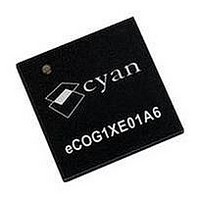ECOG1XE01A6 CYAN, ECOG1XE01A6 Datasheet - Page 26

ECOG1XE01A6
Manufacturer Part Number
ECOG1XE01A6
Description
IC, 16BIT MCU, ECOG1X, 70MHZ, QFN-68
Manufacturer
CYAN
Datasheet
1.ECOG1X14Z5.pdf
(95 pages)
Specifications of ECOG1XE01A6
Controller Family/series
ECOG1X
No. Of I/o's
20
Ram Memory Size
8KB
Cpu Speed
70MHz
No. Of Timers
8
Digital Ic Case Style
QFN
Core Size
16 Bit
Program Memory Size
64KB
Embedded Interface Type
I2C, JTAG, SPI, UART
Rohs Compliant
Yes
Lead Free Status / RoHS Status
Lead free / RoHS Compliant
Version 1.15
Port Configurator
General-Purpose I/O
Parallel I/O
Timers and Counters
26
The eCOG1X devices in the 208BGA package include 19 I/O ports, consisting of eleven 8-bit ports and
eight 4-bit ports. Devices in the smaller packages provide a subset of these I/O ports. The Port
Configurator selects how the internal peripherals are connected to the external I/O ports. Each port
may be assigned to a specified peripheral function, used for general-purpose I/O, or disabled.
The port configuration options are described in more detail later in this data sheet and in the eCOG1X
User Manual.
In addition to the peripheral selections available through the Port Configurator, all I/O port pins can be
configured individually for general-purpose I/O (GPIO) if required. GPIO pins can be configured as
inputs, outputs or bidirectional. All GPIO pins can be configured for interrupts, either edge-triggered or
level-triggered.
•
•
•
•
•
•
•
eCOG1X also contains parallel I/O (PIO) peripheral functions. PIO allows users to control groups of 8
or 16 I/O signals at a time, whereas the GPIO function provides users with signals that can be
individually controlled.
PIO is typically used for bus signals where it is necessary for the whole bus to change simultaneously,
for example driving parallel output data signals into a DAC. GPIO is typically used for controlling
individual signals, for example the output update signal to a DAC or start conversion signal to an ADC.
•
•
The timer/counter (TIM) peripheral module provides a set of hardware timing and counting functions.
Eight independent timers support a range of functions.
•
•
•
•
•
•
Timer
The clock timer TMR is a 16-bit down count timer. An interrupt is generated when the timer counts past
zero. The count duration may be preset or reset at any time. When enabled, the timer counts at its
input clock frequency, set by the SSM.
Counter
The two timer/counters CNT1 and CNT2 are 16-bit down counters. An interrupt is triggered when the
counter passes the value stored in a compare register. A second interrupt is generated when the
counter passes zero. The count duration may be preset or reset at any time, and reload can be manual
or automatic. In addition these timers may be configured to count on either or both edges of an
external clock input.
When configured as timers, they count at their input clock frequencies, set by the SSM. Alternatively,
when configured as counters, they count when a selected edge occurs on their external clock signal
inputs. These timer/counters are therefore suitable for counting external events in a target system.
Up to 120 GPIO port pins.
Individually configurable as inputs, outputs or bidirectional.
Outputs driven, open-drain or tristate controlled.
2mA source/sink output current (ports A, B, K, L, N, P, Q, R, S, T).
4mA source/sink output current (ports C, D, E, F, G, H, I, J, M).
Open-drain output option with internal pull-up resistor (ports A, B, K, L, N, P, R, S, T).
5V tolerance (ports B0-4, K, L, N, P, Q).
Two 8/16-bit parallel data ports, configurable as inputs, outputs or bidirectional.
Outputs driven, open-drain or tristate controlled.
16-bit timer TMR.
Two 16-bit timer/counters CNT1, CNT2.
Two 16-bit timers PWM1, PWM2, providing a pulse-width modulated output signal.
16-bit watchdog timer WDOG.
16-bit event capture timer CAP with up to 6 capture inputs.
24-bit long interval timer LTMR.
eCOG and CyanIDE are registered trademarks of Cyan Holdings plc
eCOG1X Microcontroller Product Family
www.cyantechnology.com
4 August 2009




















